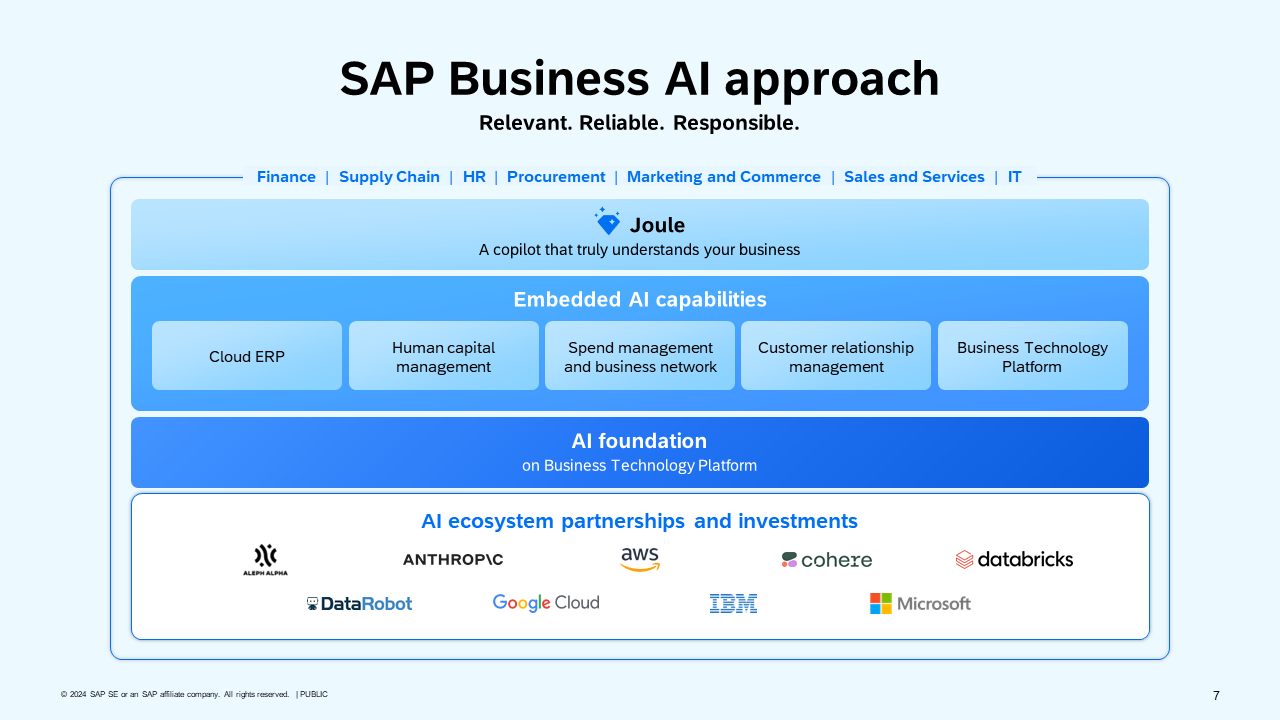Unlocking the value of Generative AI in SAP Cloud Solutions
Generative AI has firmly established its value with a versatile set of applications and is rapidly realizing its potential of elevating business outcomes. At recent events of SAP SAPPHIRE 2023, a central theme was the transformative power of Business AI, where SAP showcased seamless integration of generative AI in their cloud portfolio.
To accelerate this journey, SAP is leveraging the best tools and technologies already available in the market having struck several partnerships this year - with Microsoft, IBM and Google Cloud. Moreover, investments in leading generative AI startups like Aleph Alpha, Anthropic or Cohere empowers SAP to use their core models and technologies and tailor them to a specific business context. Integration of these solutions into the core SAP application ensures that customers can directly start benefiting from these rapid technology advancements.

We recently had a stimulating conversation with Andreas Welsch, VP & Head of Marketing and Solutions – Artificial Intelligence, SAP. His team incorporates the big AI trends in the industry into SAP applications and develops a clear communication and go-to-market strategy for their customers. In these exciting times, Andreas shares his perspectives on vital aspects and considerations around generative AI – from business applications and benefits, interpretability for human collaboration, data security and ethics, to learning opportunities and more.
Generative AI opens a new world of opportunities
The last nine to twelve months have been a whirlwind with all that the industry has seen around ChatGPT powered by generative AI. It is not only about generating, summarizing, and translating text or generating code, but revolutionizing capabilities like generating images in audio and video that look and sound like a human. These find numerous applications in both the consumer and business space.
Andreas elucidates how SAP is embedding AI into its portfolio, going beyond the basic interactive chat to make it more specific and relevant to users. One is by augmentation of generic AI language models with a contextual business layer and the other is around extraction and summarization of information from various sources, formats, templates, and languages - both directed to expedite and improve the quality of business decisions.
However, he also cautions, ‘while generative AI presents a lot of opportunity and potential, we must not forget that statistics, machine learning other technologies have been around for a long time. It doesn't mean that suddenly, they are obsolete. We still need them; we can lay generative AI on top to pull data from a base machine learning or statistical model. So, it's really the combination, it's not a replacement….be realistic about what you use when, find the right tools for the right task.’
A continuous roadmap for innovation
SAP has picked scenarios across business functions such as Finance, Supply Chain, Human Resources, Sales and Marketing, IT and Platform to demonstrate the application of generative AI and its impact. The announcements at SAPPHIRE 2023 included 8 use cases that will progressively become available to customers starting the last quarter of 2023.
On enquiring how SAP selects these cases, Andreas explains that it is a mix of approaches. One is an outside-in view to assess and address the most common recurring pain points from customers. The other is an inside-out evaluation of their current product portfolio through an AI lens to identify gaps or opportunities together with the SAP solution and product management teams.
Andreas passionately says, “we are really excited about seeing these features incorporated in our products and eventually into the hands of our customers”. He goes on to elaborate on a few upcoming applications.
1. HR – Creation of effective job descriptions:
At the time of hiring, you usually go in to look for an old job description and each time you hire you make changes as it is outdated. This is very cumbersome and time consuming. Here generative AI comes in to help get a good job description right out of the gate. Now ChatGPT could probably generate one, but it will not be very specific to your business. That’s where the team leverages valuable information already available in your SAP systems like SAP SuccessFactors to augment and tailor the job description to attract more qualified candidates with the skills you want to bring in to your organization.
2. Logistics – Efficient audit of incoming deliveries:
With the same base language models, generative AI goes beyond the chat interaction type GPT that people are more familiar with. For instance, picture a logistics scenario in a large manufacturing company, where thousands of shipments arrive daily at the plant. The logistics clerk needs to verify the quantities on a trailer against those stated in the supplier document. Working with hundreds of suppliers, each having their own version of the document (different templates, language etc.) can be cumbersome. Here generative AI simplifies the process by extracting this complex information and summarizing it in a standard usable format, thus enabling an efficient audit.
3. Finance – Accelerated response to disputes:
AI is helping create ‘communication intelligence’ to ease decisions. Imagine an email (trail) with a customer disputing an invoice - maybe an incorrect amount or different terms or improper discount application. Normally, the service reps at the shared service centers would need to open the email, read, and understand the context and finally decide what to do with it. This is tedious and time consuming. Generative AI helps pull out the key information from the email (trail), summarizes and gives recommendations on what can be done by the service rep e.g. should you open a dispute case that goes over to a dispute manager who can make a decision on how to handle the case? Or is it something where you can get more information yourself and just directly respond to the email.
4. Sales – Improving customer experience:
Generative AI can help sales reps get more summarized and tailored information around customers, akin to a customer 360 and even includes summaries of the action items discussed in the last meeting, the areas for follow up etc. to enable more effective customer conversations.
5. Marketing and Commerce – Efficient descriptions and faster content:
The technology is being deployed to create product descriptions for items in the business catalogs or generate blog posts using information available from the catalog and general known information about the business in that industry. This goes a long way in increasing the effectiveness of the teams.

Joule, a generative AI copilot truly understands your business
A key landmark for SAP in 2023 was the unveiling of Joule, SAP’s natural language generative AI copilot designed to enhance performance of their cloud enterprise portfolio and transform business operations. Joule revolutionizes how users interact with and experience SAP business systems. It categorizes, summarizes, and contextualizes insights from not only SAP applications but also third-party applications thus accelerating decision-making. This innovative copilot is not only agile and efficient but also prioritizes security and compliance in its operations.
Andreas proudly says ‘our AI copilot truly understands your business…it is advanced, user friendly and intuitive. Most importantly, it respects the core data security concepts already established in the SAP environment. For example, if a user is not allowed to see the sales forecast for this quarter, then Joule will not make that available to the user either.’
Data Security is at the center of design
Responding to critical concerns around data security, more so with the added complexity of third parties, Andreas agrees it is a very pertinent topic, ‘customers do have valid questions and want to ensure there are systems and checks in place to prevent their data from being shared with third parties’. However, he goes on to assure and strongly assert SAP’s stance, ‘it’s a clear no, we do not share our customer data with our partners for the purpose of re-training their models’. To bring home the point, he refers to job description case ‘we use the base language model of our partners and add customer contextual vectors to have more tailored prompts through a method called retrieval augmented generation. So instead of just saying ‘create a job description’ for a developer, you can add ‘with the following skills’ and get more specific results to your business. These customized results stay only in the customer’s own SAP environment and do not flow back to the base model.’
AI is built for human collaboration, for having people in control
Andreas talks abouts ‘Intelligence system design guidelines’ that govern SAP Business AI. He pragmatically states, ‘one of our core principles is that we designed AI for people, so there's really this connection and synergy between AI and people. AI helps you gather or generate information, but as a human you need to be in control, you need to be the final one making that decision because ultimately, the accountability is with you as well. That's the essence of how we are approaching AI.’
He recounts an example where they were working with a large life science customer on matching incoming payments to open invoices in finance. An early version of the model showed 92% confidence that a particular payment belonged to five specific invoices. How do you even know if that's good or bad? And what does 92% even tell you? Additional information or context to the user like the reason for match and why the model comes up with a decision (even if not totally correct) is vital. It helps understand if we need to troubleshoot or retrain the model. Hence transparency and interpretability are key to building trust and adoption by the user.
Keeping up and staying tuned in
On being asked for tips to learn more and stay up-to-date, Andreas references several resources.
The best practical starting point would be the SAP AI webpage. It is organized by business functions - Finance, Supply chain, HR and so on - to give an overview of what is available in a specific area.
Further he urges customers to talk to their SAP team about features they can take advantage of today, ‘we have many AI capabilities already existing across our cloud portfolio that we've been building and integrating for the last several years and are now available as default…these are quick wins.’
For those seeking deeper understanding and learning, he recommends two online sources - one is Open SAP where new classes around AI and generative AI are being continuously added. The other is the SAP Learning hub, offering learning journeys by persona or topic, where AI is increasingly being applied.
Finally, he advises looking out for ongoing SAP events e.g., SAP TechEd in Nov 2023. ‘Things are moving very quickly around AI, staying tuned for these events and announcements would be key’.
AI makes users more productive and effective
The impact of generative AI solutions goes beyond time and cost reduction, helping users improve their quality of work and areas where they spend their time. Andreas relays ‘when we talk to our customers, across the board we hear that people are spending so much time on operational topics and tasks that they don't have time to look at other parts of the business or see how they can innovate or work differently and the added value that they can deliver to the company.’
Talking of AI creating both top-line and bottom-line impact, he goes on to add ‘both camps are finally intended to make users more productive and effective’. While on one hand, it frees up time and increases efficiency, on the other it impacts customer loyalty and sales where users get better insights and information to have better conversations with their customers. ‘If our customers are successful and give positive feedback, it helps us confirm that we're on the right path and can pursue additional opportunities. In the end, we can only be successful if we make our customers successful.’
To wrap, SAP has been working on Business AI and building applications for several years. Business AI at SAP is intended to solve specific problems and situations in a business process by leveraging data already available in SAP systems combined with deep industry knowledge and process expertise of more than 50 years. These AI applications are designed to empower users to run businesses faster, provide smarter insights and better business outcomes by giving full control over decision making in not only a relevant and reliable but also responsible fashion. Andreas closes with ‘I am super excited and proud that over 24,000 customers are already using AI from SAP in their applications. Ultimately, anything we do is because we want to help our customers. We're helping get real results from AI…it is not just hype, it’s a real value driver’.
For more information kindly refer to:
SAP AISAP Learning
SAP Events
Interviewee: Andreas Welsch, VP & Head of Marketing and Solutions – Artificial Intelligence, SAP
Interviewer: Frans van Hoesel, VNSG
Article: Radhika Gupta, Business and Digital Transformation Writer



